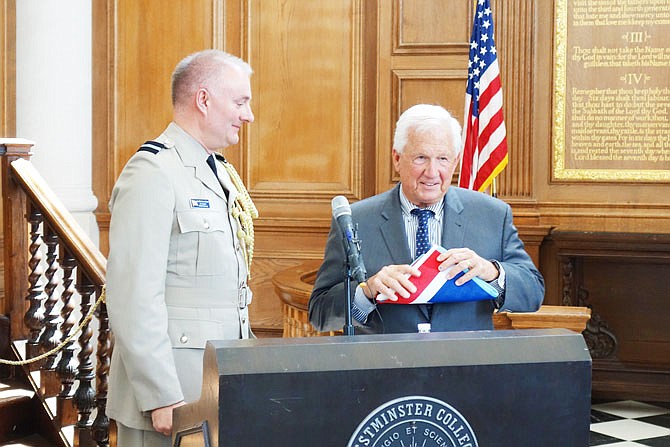Even before America joined World War II, a few brave American pilots joined the United Kingdom's Royal Air Force in defending against the blitz.
These pilots made up three Eagle Squadrons, formed between 1940-41. One of Fulton's own was among 144 pilots who never came home. During a special ceremony Wednesday at the National Churchill Museum, dignitaries including an RAF air attaché honored the Eagle Squadrons through the presentation of an RAF flag, or ensign.
Churchill Museum Curator and Director Timothy Riley started the ceremony off by reminding the audience of the special relationship between the UK and America. Then-Prime Minister Winston Churchill coined the phrase "special relationship" during his famed Iron Curtain speech at Westminster College.
Brig. Gen. Maurice McKinney, the Missouri Air National Guard's chief of staff, and Randell Gelzer (senior director of state and local government operations for Boeing), read excerpts from Churchill's speeches. Churchill said of the pilots defending his nation: "Never in the field of human conflict was so much owed by so many to so few."
"Today, we honor that special relationship in a special way," Riley said.
There are ties between the Church of St. Mary the Virgin, Aldermanbury and the Eagle Squadrons, too. In 1992, the church on Westminster's campus was dubbed the official chapel of the Eagle Squadrons.
The squadrons still exist and are now part of the 8th Air Force of the United States, stationed in North Carolina. Comm. James Linter, air attaché for the RAF, said an RAF officer still serves with today's Eagle Squadrons. Historian Gary Joyner, of Louisiana State University, Shreveport, noted an obelisk honoring the Eagle Squadrons stands today in London.
"The close affiliation epitomized by the Eagle Squadrons is just as important today as it was in England's darkest hour," he said while presenting the RAF ensign to Westminster President Fletcher Lamkin.
He said he hopes the flag's presence at Westminster strengthens the special relationship between the U.S. and Missouri and the UK.
"May all who look upon it be reminded of their duty to God and to country," Lamkin added.
Lutz
Wednesday's ceremony also marked the opening of new exhibit "The Few: Winston Churchill, the Royal Air Force and the Battle of Britain" at the museum. Among the items on display is a letter from First Lt. John F. Lutz's best friend Howard Hively to Lutz's mother, living in Fulton.
Lutz, nicknamed Pappy, was born in 1918 in Fulton. After graduating from Fulton High School, he spent a year at Westminster College before transferring to Brawley Junior College, graduating the following year. In 1941, he enlisted in the RAF as part of the Number 71 Eagle Squadron. He was 23 and was risking everything.
Under U.S. law, joining a foreign country's armed forces was punishable by losing one's citizenship. Even traveling to the UK was a challenge.
"Their route to get there was an interesting one," said Lt. Gen. (Ret.) Richard Harding, formerly Judge Advocate General of the United States Air Force. "Some went through Canada."
Lutz trained on Spitfires. Once the United States joined the war, the Eagle Squadrons became part of the Mighty 8th Air Force and began using P-47s. As a fighter pilot, Lutz was tasked with protecting bombers as they flew either to or from their targets - with shorter ranges than the B-17 bombers, P-47s couldn't make it all the way there and back on one tank.
"On the fourth of May, 1943, (Lutz) was picked to escort fighters home from a bombing run on Antwerp," Harding said.
It would be his final fight.
Hively watched from his own plane as Lutz swooped toward six Luftwaffe aircraft.
"Pappy made good his attack, but in the melee evidently got a bullet in the oil line or such," Hively wrote.
Noting his craft was acting up, Lutz radioed Hively to say he was heading home. Halfway across the North Sea, he called again to say he was bailing out.
"The words he used, ma'am, were: 'Hively! It's a damn shame, but I'm going to get my new boots wet!'" Hively recalled.
Lutz bailed out at around 2,000 feet. His chute failed to open and neither he nor his plane was ever found.
"Though you have lost your son, ma'am, it may help you to know that he went as any man would be proud to go - doing his duty protecting an ideal he loved, and with a joke on his lips," Hively added.
That letter and other artifacts may be viewed at the National Churchill Museum.

